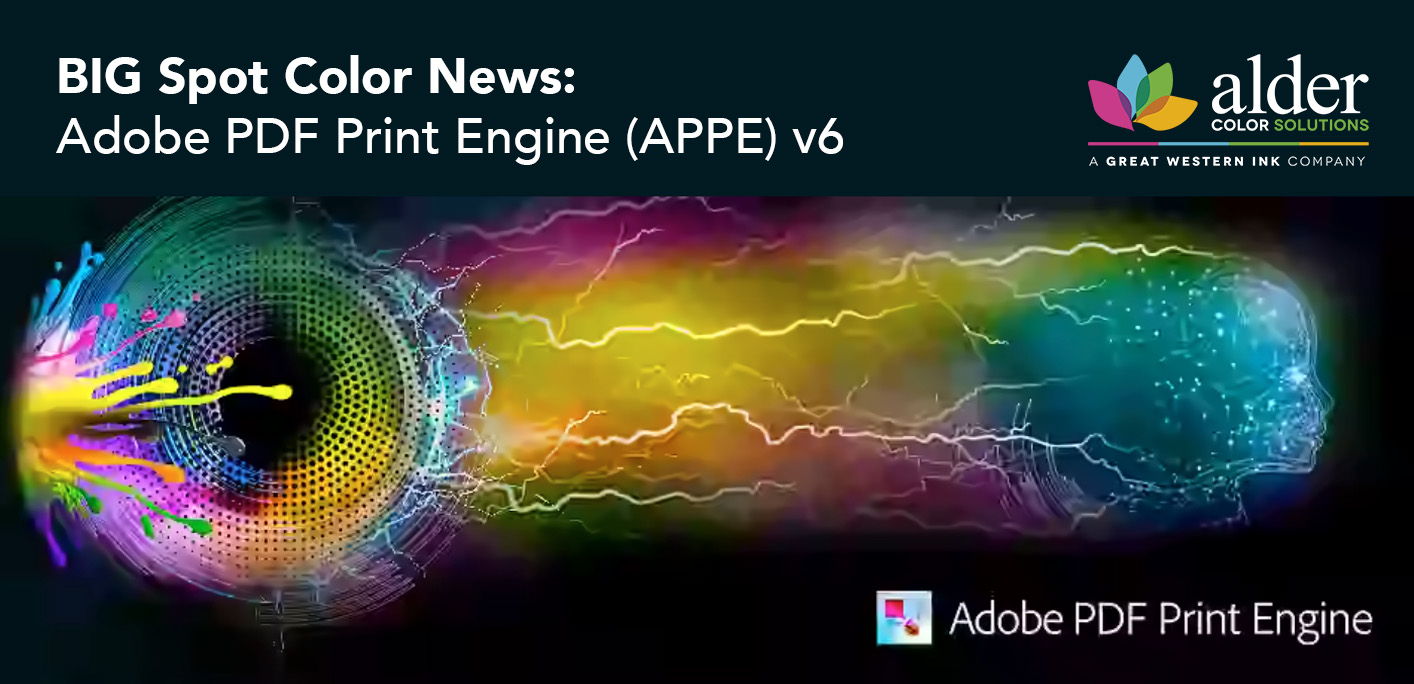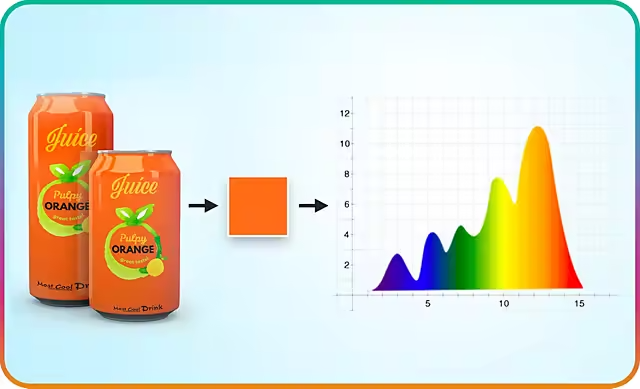BIG Spot Color News – Adobe PDF Print Engine (APPE) v6
In June of 2022 Adobe announced the release of the next generation Adobe PDF Print Engine (APPE). This print engine technology is the industry standard for interpreting PDF artwork files and is licensed to many printer and software (DFE/RIP) companies like Epson, HP, EFI, ONYX, Caldera, etc. The licensed APPE also includes Adobe’s Color Engine (ACE), which enables color conversions of RGB, CMYK, multi channel (nCLR/ECG) and spot color images and elements in PDF documents automatically. APPE v6 has major and significant advancements, which I’ll point out in detail.
Adobe Resources:
https://www.adobe.com/products/pdfprintengine.html
https://www.adobe.com/products/pdfprintengine/whats-new.html
https://www.adobe.com/products/pdfprintengine/corestrengths.html
APPE v6 now has the ability to interpret spectral definitions of spot colors
Critical functionality to reproduce spot colors tints and gradients
This is BIG! The master digital definition of any color is a spectral reflectance curve. All LAB values are derived from this spectral definition for a particular illuminant and observer angle, and M mode, which is how all of the Pantone libraries are distributed. These LAB values only define the solid color (100%) and have no transparency definition (spot color inks aren’t totally opaque).
Many times designers overprint spot colors in their artwork and there’s no way for this to be interpreted properly without the spectral definitions. In addition, the LAB values for the solid color do not include any tint information. Many designers don’t only use 100% solid spot colors but tints or gradients of colors (and even tints/gradients of colors that are overprinting one another).
The ability to define a full characterization spectral color (that defines all the tint values and transparency information) has been around for many years (details here – https://www.color.org/CxF_test.xalter regarding ISO 17972-4:2018) but most DFEs/RIPs couldn’t make use of this spectral definition because it just wasn’t supported – until now! This is critical functionality to reproduce/match spot colors, especially overprints and tints, accurately.
Spectral Data Questions
This “Dov” tails (pun intended) right into what’s going on with PDF 2.0 and PDF/X-6. This topic was explained very well in a presentation my colleague Dr. Dov Isaacs did a few years back, which you can see here: https://color.printing.org/wp-content/uploads/2019/01/Isaacs-EndtoEndPublishingPDF.pdf
Now you’re probably (or hopefully are) asking yourself some questions, like…
Do the existing Pantone libraries include spectral data?
No. Well, it’s kind of a trick question. Pantone’s master definitions are all spectral but you can only reference them in their PantoneLIVE platform via subscription. The libraries that are/were included in Adobe apps and other software like RIPs are not spectral.
Are there other color libraries that do include spectral data?
Yes. The one I am most excited about, like really excited (I know, I’m a ColorGeek, I can’t help it) is called ChromaSpot and it hasn’t even been officially released yet but I’ve been beta testing it and have permission to talk about it as the official release is going to happen any day now. I will be doing another blog post specifically about ChromaSpot but you can read more about it here: https://chromachecker.com/manuals/en/show/chromaspot
Does this mean you may need to measure/define your own colors?
Yes. The key word here is “may”. But with an open architecture, substrate-independent, free, all spectral library, available to download and import (ie ChromaSpot), you “may” not have to measure/define your own colors.
How do you create a spectral color definition?
Easy, you use a spectrophotometer and software to measure the color from any object/swatch. I would highly recommend you read another blog I wrote here: https://aldertech.com/product-spotlight-chromachecker-capture/
What file format do you save the spectral definition?
There are options but CxF format is the ISO standard. DataColor has their own proprietary format QTX. Both ACB (Adobe Color Book) and ASE (Adobe Swatch Exchange) are formats to save color libraries but they only support Lab, RGB, CMYK values. So, you keep your master lists in CxF and you convert copies to ACB or ASE for use in Adobe CC. If you need the libraries to show up in Channels, you must use ACB format. I use a very powerful software program module called Coraye Color Table to import and export color tables/libraries to whatever format I want. You can find out more about this on our online store here: https://aldertech.com/product/coraye/
Can you import the spectral CxF file into Adobe Photoshop, Illustrator, InDesign, etc?
No. Adobe still doesn’t support spectral definitions or CxF files in CC apps, so you’ll need to convert the CxF to ACB/ASE, then you can import it.
What do you do with the CxF file?
Many things…
1 – You could send it to an ink lab to have ink formulated.
2 – You could email/send it along with your print-ready PDF artwork file to whomever is printing it. Hopefully they’re color savvy enough to know what do with it – if they’re not, beware (red flag).
3 – You could embed it into a PDF (with 3rd party software), swapping out the LAB values for the spectral definition.
4 – You could import it into your proofer DFE/RIP software (APPE v6 only) and do named color replacement to use it.
5 – You could import it into a color server software program like Alwan ColorHub, ColorLogic Zepra, or GMG ColorServer.
6 – You could sync it to an instrument like an X-Rite eXact or load it into software to compare against for quality control, ensuring the color accuracy within a specified tolerance.
The future with APPEv6
Now, before you get all excited, you should know that the list of software‘s that currently support the new APPE is a short list. As far as I know, Caldera really is the only one to release their version 16 with a APPE v6 so far. There’s no telling how quickly other RIP manufactures will release new versions with APPEv6 or how they’ll choose to implement the new functionality available within APPE v6. But once they do, this will need to be tested and proven that it works properly. In any case, this is absolutely a BIG announcement, significant technological advancement and something you should be aware of and planning to take advantage of. Should you need any help doing that please don’t hesitate to reach out to me.



